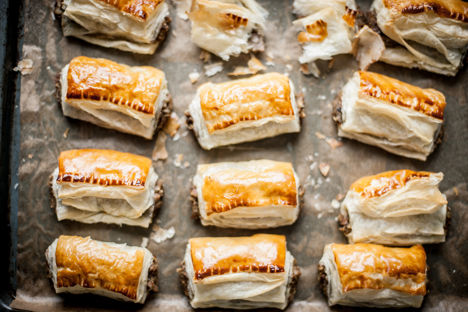This versatile pastry can be used for all sorts of recipes, from breakfast croissants and cinnamon rolls, to savoury and sweet tarts and pies and classic desserts like mille feuille. Good quality, storebought, all-butter puff pastry is great for a quick fix, but making your own is the kind of skill that can elevate your kitchen repertoire.
Is puff pastry the same as other pastry?
Puff pastry is quite different to other pastries, such as delicate filo and crumbly shortcrust, thanks to the way it is made. Puff pastry uses a process called lamination which involves the pastry being repeatedly folded with butter in many layers, and it is this that gives it its distinctive layered rise and pillowness when baked.
How do I make puff pastry?
Puff pastry is made by mixing butter and cold water or milk into flour and salt, rubbing it together until it forms flakes. This mixture then is brought together into a ball and shaped into a block called a détrempe which is chilled. The pastry block is then rolled out and folded over a flattened rectangle of butter, encasing it completely. This is then is rolled and folded again twice before chilling, followed by two more fold and rolls.
How should I store puff pastry?
Puff pastry should be kept chilled until you need it. Tightly wrapped in clingfilm it can keep in the fridge for up to three days. But if chilled for more than three hours you will need to leave it to come to room temperature for about 5 minutes before attempting to roll it out. You can also freeze wrapped puff pastry for up to six months. But be sure to defrost it in the fridge, rather than at room temperature, in order to stop the butter layers from melting.
Metric
Imperial
- 500g of Doves Farm Organic Plain White Flour
- 250ml of milk
- 150g of butter, diced, plus a 200g block
- 1/2 tsp salt
Use your fingertips to rub the diced butter into flour until it reaches a loose breadcrumb consistency. Add the milk and use your hands to bring together the pastry and form it into a rectangular block. Wrap the block in cling film and refrigerate for at least 20 minutes
- 150g of butter, diced, plus a 200g block
- 500g of Doves Farm Organic Plain White Flour
- 250ml of milk
- 1/2 tsp salt
Roll out the pastry on a floured surface into a flat rectangle – approx. 1cm thick – this is your détrempe. Keep the sides straight as this will help you when folding the pastry later on. It should be roughly three times as long as it is wide with neat edges and corners.
Place the 200g of butter between two sheets of greaseproof paper and bash it flat using a rolling pin to half the size of the détrempe and rectangular shaped
Remove the butter from the paper and place it on the bottom half of the rectangle. Fold over the top half of the pastry to cover and 'seal in' the butter
With the folded edge pointing away from you, roll out the pastry to a rectangle roughly 3 times as long as it is wide as in step 2
Fold the bottom third of the rectangle into the centre. Now fold the top third on top of that so the pastry is now three layers thick. Rest in the fridge for at least 20 minutes
Remove from the fridge and place the pastry on a floured surface with the folded edge perpendicular to you then repeat steps 5 and 6 again for a total of 6 times, resting for 20 minutes in the fridge between each folding
Finally roll the pastry out to your desired thickness. For a pie it should be about 1cm thick
Top tips for achieving the flakiest puff pastry?
Make sure you don’t overwork the dough, as this will activate the gluten in the flour and make it tough. And always use a long, sharp knife to cut down through the pastry in one downwards movement. Using a serrated knife or dragging a knife through the pastry will cause it to tear and it will not rise properly.
For more top tips on how to handle and cook your puff pastry check out our guide.
Can I make puff pastry in a food processor?
You can use a food processor to bring the initial dough together. Using a blade to whizz your flour, butter, salt and water or milk until the dough just starts to clump together. Then stop whizzing, remove from the processor and press into a rectangular block. Wrap and chill as above, then proceed with the process above from step 2 onwards.
What is rough puff pastry?
Rough puff is a kind of cheat’s version of puff pastry that is quicker and less involved to make, hence the name. Instead of a single layer of folded butter it uses cold diced or grated butter, or leaves the extra butter out completely, before folding and rolling fewer times than with classic puff. Try Galton Blackiston’s recipe for rough puff cased filled with honeyed figs and ice cream.
How can I use puff pastry?
Puff pastry makes a great base or shell for canapes such as vol-au-vents – serve these retro-cool bites at your next gathering with Helen Graves’ recipe.
It is, of course, also classically used for sausage rolls and Beef Wellington, as well as a topping for pies such as Food Urchin’s. It forms an easy base for tarts, such as classic French pithiviers and pissaladieres, as with Pierre Koffmans’s version. The most famous puff pastry dessert is probably tarte tatin – for a sensational spin on the traditional recipe try chef Woongchul Park’s daikon version, with radishes cooked until soft and buttery with a barley glaze.
What can I do with leftover puff pastry?
Gently roll any leftover pastry into a ball and wrap in clingfilm and chill for 1-2 days or freeze for up to 6 months. You can roll this out (defrost if frozen following the advice above) and cut into strips to make cheese twists, or spread with mincemeat roll and slice to make these delicious palmiers by Adam Byatt.
Get in touch
Please sign in or register to send a comment to Great British Chefs.



